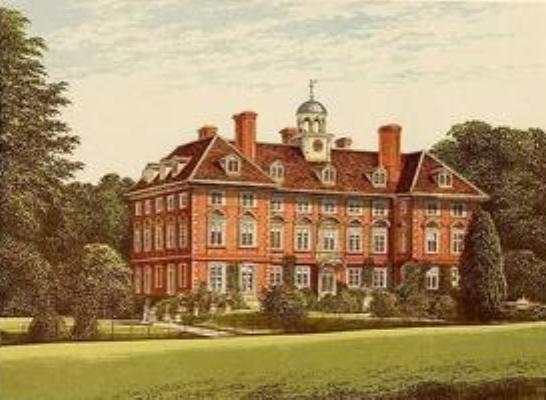
Tyttenhanger Green,
near St Albans
Before 1845 it was in the parish of St Peters, It is now in the parish of Colney Heath.
The name Tyttenhanger - as Tydenhangre - is first recorded in 1248 and probably means the "wooded slope belonging to Tida."
from The Place-names of Hertfordshire.
Tyttenhanger is a hamlet one mile north [of
London Colney] in the parish of St Peter
[St Albans], and partly within the borough of St
Albans. The population in 1861 was 620.
from Post
Office Directory, Herts, 1866, [archive CD]

Tyttenhanger House - from a late 19th century(?) print
The following account, dated January 1797, comes from the Gentleman's Magazine, and is reprinted in Hertfordshire 1731-1800
In the year 1547, Sir Thomas Pope, founder of Trinity college, Oxford, bought of King Henry the Eighth the ancient stately mansion house of Tyttenhanger, in the parish of Ridge, Hertfordshire, being the country seat of the abbots of St. Albans; and which, but for this purchase, would have been destroyed as an appendage to the abbey. This house was so large, that, in 1528, King Henry the Eighth, with his queen Catharine, and their retinue, removed hither during the continuance of the sweating sickness in London.
In this house Sir Thomas Pope made great improvements. It became his favourite place of residence, and the statutes of his college are dated thence. He erected over the vestibule of the great hall a noble gallery for wind music. This chapel was a spacious edifice, and beautifully decorated. The windows were enriched with painted glass, which Sir Thomas Pope brought hither from the choir of St. Albans abbey, when that church, by his interposition with the king, was preserved from total destruction. The wainscot behind or over the stalls was finely painted with a series of the figures of all the saints who bore the name of John, in memory of John Moot, one of the abbots. But Sir Thomas Pope put up a new piece of wainscot, of Spanish oak, on a very large scale) at the east end, most exquisitely sculptured, beginning at the end of the stalls, and continued towards the altar. This was to adorn that part of the chapel which was usually called the presbytery, or the space about and near the altar.
After Sir Thomas Pope's death, in 1559, Tyttenhanger House continued to be inhabited by the relations of his second wife, bearing the name of Pope-Blount. In the year 1620 it began to be lessened, or pulled down in part; about which time the family of Napier, then tenants to Trinity college (Oxford) at Luton, by the mediation of the college, removed the wainscot (above mentioned), put up by Sir Thomas Pope in the chapel of Tyttenhanger House, in entire preservation) to the chapel of the mansion house at Luton. John, Earl of Bute, about the year 1768, pulled down this old mansion house at Luton, to build a new house in its place; but, with great taste and judgement, retained the old chapel, with Sir Thomas Pope's wainscot, where it still remains. {Bibl. Top. Brit. V111.69).
No traces of the old house at Tyttenhanger now remain. It was totally demolished about the year 1652, and was soon afterwards most elegantly rebuilt as it appears at present. T. Warton.
The Book of Colney Heath includes information on the history of Tyttenhanger Green
See also Old Tyttenhager News
Census: 1861: Parts of area included in Middlesex
Updated June 2009 [link to Colney Heath book added]